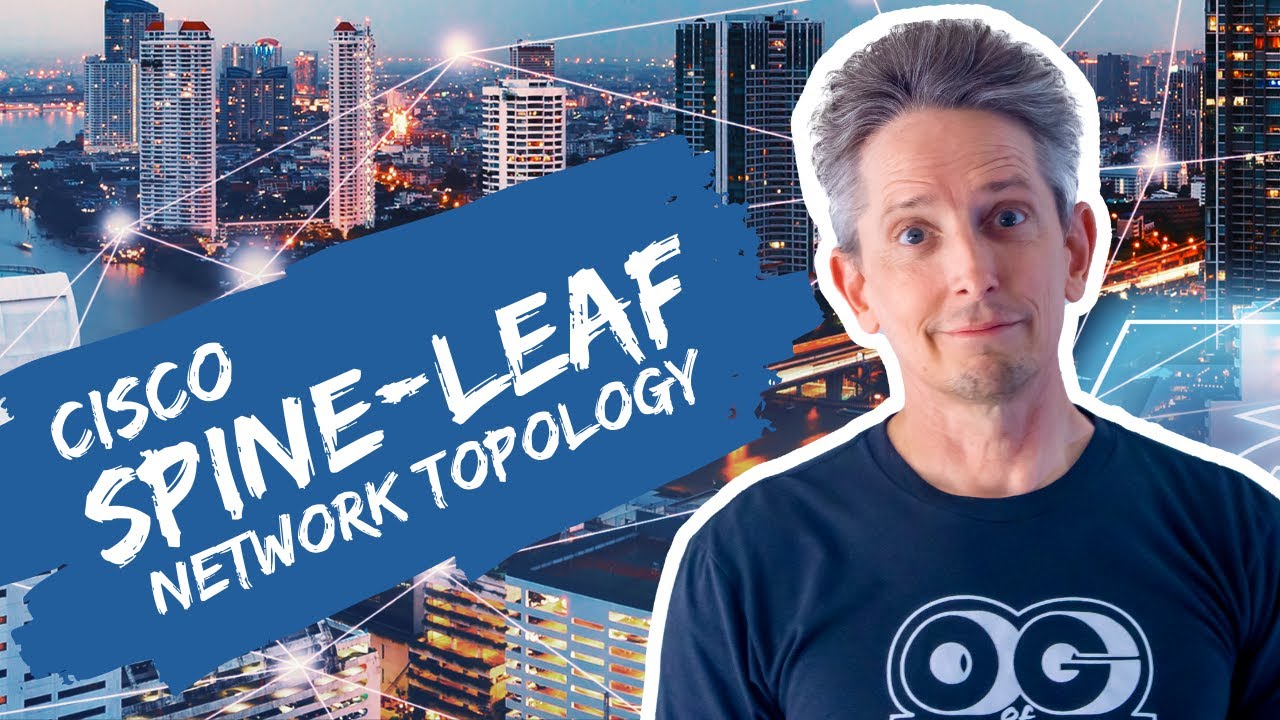Cisco ACI Explained: Master Spine-Leaf Architecture in Minutes!
Summary
TLDRThis video introduces Cisco's Application Centric Infrastructure (ACI), focusing on its innovative two-tier Leaf-Spine architecture. The ACI model provides a scalable, non-blocking network with high-speed connectivity for data centers, using VXLAN overlay for virtual network abstraction. Key concepts include Endpoint Groups (EPGs), intent-based networking (IBN), and policy-driven communication between application tiers. ACI transforms traditional data center networking by automating configurations and ensuring predictable, secure designs. The video also discusses the integration of various components like APIC controllers, VM workloads, and external routers to create an efficient, future-proof data center infrastructure.
Takeaways
- 😀 ACI stands for Application Centric Infrastructure, which uses a two-tier Leaf-Spine architecture, also known as CLA fabric.
- 😀 The Leaf-Spine architecture is designed for data centers and offers a non-blocking fabric with scalability and high-performance capabilities.
- 😀 Leaf switches connect to all spine switches, and vice versa, but spines do not connect to each other, providing a highly redundant and resilient design.
- 😀 The architecture supports ECMP (Equal Cost Multipath) design, ensuring all links are active and used for load balancing between servers.
- 😀 ACI provides a predictable design, eliminating the complex, unique configurations found in older network architectures, ensuring easier automation.
- 😀 In ACI, endpoint connections are made only to leaf switches; spines never have endpoints directly attached to them.
- 😀 The design leverages VXLAN overlay technology to allow VM communication across multiple physical hops, making VMs appear as though they are directly connected.
- 😀 Cisco's Nexus 9300 series switches are typically used for leaf switches, and Nexus 9500 series switches are used for spine switches in ACI designs.
- 😀 The ACI model includes the APIC (Application Policy Infrastructure Controller), which connects to leaf switches for network control and policy enforcement.
- 😀 ACI uses underlay and overlay models: physical components like switches and servers are underlay, while VXLAN and other services like VMotion are part of the overlay.
- 😀 ACI's logical architecture involves defining application network profiles using endpoint groups (EPGs) and policies that govern how different application layers interact, with emphasis on security and micro-segmentation.
Q & A
What does ACI stand for and what is its main purpose?
-ACI stands for Application Centric Infrastructure. Its main purpose is to provide a two-tier Leaf-Spine architecture for data centers, which facilitates efficient, non-blocking, and scalable network designs that support high-performance requirements.
What is the significance of the Leaf-Spine architecture in ACI?
-The Leaf-Spine architecture in ACI creates a non-blocking fabric where all Leaf switches connect to all Spine switches, ensuring active-active paths and a scalable, predictable network design. It eliminates bottlenecks and provides better performance in data centers.
How is ACI's network design scalable?
-ACI's design is horizontally scalable, meaning you can add more Leaf switches as needed. Once the capacity of the Spine switches is reached, additional Spine switches can be added, maintaining the performance and scalability of the network.
What is ECMP (Equal-Cost Multipath) and how does it function in ACI?
-ECMP, or Equal-Cost Multipath, is a design feature in ACI that allows multiple active links between Leaf and Spine switches. Traffic can be load-balanced across all available links, ensuring efficient and redundant data paths.
What is the role of the APIC controller in ACI?
-The APIC (Application Policy Infrastructure Controller) is responsible for managing and orchestrating the ACI fabric. It controls and monitors the network, ensuring the implementation of policies and managing the flow of traffic across the data center.
What is the difference between the underlay and overlay in ACI?
-In ACI, the underlay refers to the physical network infrastructure, including Spine and Leaf switches, and endpoints like servers and routers. The overlay, on the other hand, is a virtual network built on top of the underlay, typically using technologies like VXLAN, enabling logical segmentation and advanced features such as VM mobility across data centers.
How does ACI enable VM mobility across data centers?
-ACI enables VM mobility through the VXLAN overlay, which allows virtual machines to move across data centers while maintaining Layer 2 connectivity. This is achieved by creating an end-to-end tunnel that spans the physical network, allowing seamless migration such as vMotion between geographically dispersed data centers.
What are Endpoint Groups (EPGs) in ACI and what role do they play?
-Endpoint Groups (EPGs) are collections of endpoints that share the same policy and can communicate with each other. They are fundamental in defining how different elements in the network, such as VMs or physical servers, interact based on their assigned roles or services in ACI.
What is the purpose of a policy contract in ACI?
-A policy contract in ACI defines the rules for communication between different Endpoint Groups (EPGs). It specifies which traffic is allowed between groups, ensuring secure and controlled interactions within the data center, preventing unauthorized access between tiers like the web, app, and database.
How does ACI provide micro-segmentation and security?
-ACI supports micro-segmentation by allowing granular policies for traffic control at the endpoint level. This enables security at a very detailed level, ensuring that only legitimate communication occurs between endpoints, while preventing unauthorized access and potential threats.
Outlines

This section is available to paid users only. Please upgrade to access this part.
Upgrade NowMindmap

This section is available to paid users only. Please upgrade to access this part.
Upgrade NowKeywords

This section is available to paid users only. Please upgrade to access this part.
Upgrade NowHighlights

This section is available to paid users only. Please upgrade to access this part.
Upgrade NowTranscripts

This section is available to paid users only. Please upgrade to access this part.
Upgrade NowBrowse More Related Video
5.0 / 5 (0 votes)





